Anybody had problems with their CMS-60D?
Re: Anybody had problems with their CMS-60D?
Hey Bev, good luck with the overnight pulse-ox.
I find this whole topic very interesting. While it seems unlikely that one's pulse could jump up to 200+ so quickly and for such a short period, you do report that the desaturation does seem to be correlate with your tiredness, so it's hard tell if these wildly varying numbers are indeed just artifacts or if they are real.
Physiologically, is it normal or possible for a person's o2 to vary so wildly and to jump up/down in a matter of just 1 sec??
ca_hosehead makes a good point- those moments when it records very high heart rate, can you confirm that by just measuring it manually?
I find this whole topic very interesting. While it seems unlikely that one's pulse could jump up to 200+ so quickly and for such a short period, you do report that the desaturation does seem to be correlate with your tiredness, so it's hard tell if these wildly varying numbers are indeed just artifacts or if they are real.
Physiologically, is it normal or possible for a person's o2 to vary so wildly and to jump up/down in a matter of just 1 sec??
ca_hosehead makes a good point- those moments when it records very high heart rate, can you confirm that by just measuring it manually?
PR System One APAP, 10cm
Activa nasal mask + mouth taping w/ 3M micropore tape + Pap-cap + PADACHEEK + Pur-sleep
Hosehead since 31 July 2007, yippie!
Activa nasal mask + mouth taping w/ 3M micropore tape + Pap-cap + PADACHEEK + Pur-sleep
Hosehead since 31 July 2007, yippie!
Re: Anybody had problems with their CMS-60D?
Very darn good question IMHO. I admittedly haven't had time to properly search that excellent question. But I did pick up this definition in a super quick Google search that describes SpO2 drop-off rates of greater than 5% per second being dismissed as artifact:echo wrote:Physiologically, is it normal or possible for a person's o2 to vary so wildly and to jump up/down in a matter of just 1 sec??
http://pmbcii.psy.cmu.edu/core_d/Harmon ... Report.pdf
The above also implies that these presumably measured conditions do not clinically qualify as "desaturation events": 1) SpO2-decrease measurements under 4%, and 2) SpO2-decrease measurements lasting under 5 seconds.1. A desaturation event is defined by SpO2 decrease of =4% for = 5 seconds with a maximum drop-off rate of 5% / second.
2. Values include SpO2 data from all epochs between Good Night Time and Good Morning Time, including both sleep and wake.
3. These values include all available SpO2 data, without censoring for artifact.
4. SpO2 data censored for artifacts (probe slips), defined as a SpO2 drop of > 5% / second until within 5% of last non-artifact value
I think it's entirely interesting that the medical industry now feels a need to measure SpO2 transients with much greater resolution for SDB diagnosis.
Re: Anybody had problems with their CMS-60D?
And in the fine print of the reports Bev posted from the Contec software, it gives its definition of what it considers an event, under "Analysis Parameters":
Desaturation Event: drop in spO2 by at least 4% for a minimum duration of 10 seconds.
Re: Anybody had problems with their CMS-60D?
Also a comment that the above 4% and 10-second values are Contec default settings for scoring "desaturation events". That meter will allow the user to change either of those numeric parameters so that "desaturation events" can be scored differently. (click here for CMS60D user manual download from http://healthcare.echostore.com)jnk wrote:And in the fine print of the reports Bev posted from the Contec software, it gives its definition of what it considers an event, under "Analysis Parameters":
Desaturation Event: drop in spO2 by at least 4% for a minimum duration of 10 seconds.
Forgot to mention that I was referring to this interesting article: http://www.sleepreviewmag.com/issues/ar ... -04_10.asp-SWS wrote:I think it's entirely interesting that the medical industry now feels a need to measure SpO2 transients with much greater resolution for SDB diagnosis.
Last edited by -SWS on Tue Dec 02, 2008 2:19 pm, edited 1 time in total.
Re: Anybody had problems with their CMS-60D?
Ah! VERY interesting! I didn't understand that.-SWS wrote:4% and 10-second values are Contec default settings for scoring "desaturation events". That meter will allow the user to change either of those numeric parameters so that "desaturation events" can be scored differently.
Can the 1s resolution (if I'm using the right word) be changed too? If so, would that smooth out the response?
Sorry, I'm still suffering from gadget envy!
Oh, wait, I see your link to the manual now. THANKS!!
Re: Anybody had problems with their CMS-60D?
Jeff, the Contec "refresh" parameter is fixed at 1 second on that meter. Take a peek at the user manual download I just edited into my post above.
Re: Anybody had problems with their CMS-60D?
That thing makes my MD300A pulse-ox look like an ancient child's toy. The MD300A only records the one-minute averages overnight. It could easily be missing significant dips.
Say, Bev, wanna trade? j/k
Say, Bev, wanna trade? j/k
Re: Anybody had problems with their CMS-60D?
I don't see where one would be able to change the parameters for desaturation. We can change the point at which the alarms will go off, but I don't think that changes how events are scored. When I feel better I can experiment with that.
I don't have a watch with a second hand so have not double checked my pulse. But there is no way that Jim's resting pulse is as high as it says. I think his radiation treatments make the thing go crazy.
I got a Respironics 920M-Plus around 2:30 today. I can't find on their website how often it records. So far, my O2 have been way up there in the normal range and my pulse has been over 100 for 2 hours. My written instructions say to use it tonight WITHOUT CPAP. Yeah, right, like that's going to happen.
Bev
I don't have a watch with a second hand so have not double checked my pulse. But there is no way that Jim's resting pulse is as high as it says. I think his radiation treatments make the thing go crazy.
I got a Respironics 920M-Plus around 2:30 today. I can't find on their website how often it records. So far, my O2 have been way up there in the normal range and my pulse has been over 100 for 2 hours. My written instructions say to use it tonight WITHOUT CPAP. Yeah, right, like that's going to happen.
Bev
Diagnosed 9/4/07
Sleep Study Titrated to 19 cm H2O
Rotating between Activa and Softgel
11/2/07 RemStar M Series Auto with AFlex 14-17
10/17/08 BiPAP Auto SV 13/13-23, BPM Auto, AHI avg <1
Sleep Study Titrated to 19 cm H2O
Rotating between Activa and Softgel
11/2/07 RemStar M Series Auto with AFlex 14-17
10/17/08 BiPAP Auto SV 13/13-23, BPM Auto, AHI avg <1
Re: Anybody had problems with their CMS-60D?
According to the manual the Respironics 920M-Plus is fixed at 4 second readings:OutaSync wrote:I got a Respironics 920M-Plus around 2:30 today. I can't find on their website how often it records.
http://global.respironics.com/UserGuide ... 0MPLUS.pdf
So any 1-second meter versus 4-second meter comparison should return different SpO2 data---at least regarding those very brief SpO2 transients.Page 24 of the Respironics 920M-Plus manual wrote:Patient SpO2 and pulse rate are sampled and stored every 4 seconds"
Bev, maybe the echostore link several posts above is sourcing the wrong file. Here's what that questionable manual states under the section called "Analysis" (Chinglish mistranslations included):OutaSync wrote:I don't see where one would be able to change the parameters for desaturation.
The above N and L settings are configurable by clicking on the tools icon in the lower left corner (the wrench and screwdriver logo). But the CMS-60D statistical analysis software doesn't allow for those N and L parameters to be configurable?SpO2 review program can analysis the data and print analysis reports. It does some basis statistical analysis as well as SpO2 and pulse events analysis.
SpO2 desaturation event is defined as drop in SpO2 by at least N% for a minimum duration of L seconds. N and L are configurable, and is defaulted to 4 and 10.
Bear in mind that changing N and L wouldn't change how the meter recorded anyway. It would only change how the reporting software tallies "desaturation events" on your computer long after your sleep session is done.
- feeling_better
- Posts: 803
- Joined: Sun Jun 01, 2008 7:08 pm
Re: Anybody had problems with their CMS-60D?
OutaSync, assuming you are talking about cms-60d: all those settings are in the analysis program after you download the data to your pc. As for recording, the only useful setting on the meter itself is the time at which you start recording -- you need to do this every time you start recording. All the others are related to display brightenss, download start, ...OutaSync wrote:I don't see where one would be able to change the parameters for desaturation. We can change the point at which the alarms will go off, but I don't think that changes how events are scored. When I feel better I can experiment with that.
Most doctors are really not going to look at the chart or detailed data at all. They look at the summary of the analysis, how many times it went below desat, and for how long. On the other hand, everybody here, (especially I !), is into detailed data, and for me raw data . I do not look at all any of that analysis summary.
This is the way I used the O2 graph data: On the computer screen, I lined up the graph with the graphs from my m-series data, adjusted the width of both so that I had a common time scale. For the cms-60d, there is only a starting point, no real time, but the elapsed time is accurate. So you hav to insure you start the recording meter and the cpap machine close to each other. Now, I looked for events such as OA, H, and looked at the O2 around that time. If I had a wild O2 down spike without any events at other places, I simply assumed it would have been a movement related. I had one two of these every night. However I could indded see slight reductions around OAs, and closely spaced repeated Hs. Even without cpap my o2 during initial sleep study never belwo below 85 or so.
If you have a running clock on your computer you can use that.I don't have a watch with a second hand so have not double checked my pulse. But there is no way that Jim's resting pulse is as high as it says. I think his radiation treatments make the thing go crazy.
Never mind the instructions about 'without cpap'. All instrument manufacturers want no other instrument nearby I remember I was doing a 24 hour blood pressure study, and the sleep study people did not want anything to do with anything else --- phobias of foreign wires and instruments So I had to reschedule my initial sleep study.I got a Respironics 920M-Plus around 2:30 today. I can't find on their website how often it records. So far, my O2 have been way up there in the normal range and my pulse has been over 100 for 2 hours. My written instructions say to use it tonight WITHOUT CPAP. Yeah, right, like that's going to happen.Bev
Resmed S9 Elite cpap mode, H5i Humidifier, Swift FX Bella L nasal pillows
Re: Anybody had problems with their CMS-60D?
Ahhh I get it now: the graph will still show all those desaturation events, but the analysis and summary section won't report them as desaturations unless they fit the specified N and L criteria.-SWS wrote:The above N and L settings are configurable by clicking on the tools icon in the lower left corner (the wrench and screwdriver logo). But the CMS-60D statistical analysis software doesn't allow for those N and L parameters to be configurable?SpO2 desaturation event is defined as drop in SpO2 by at least N% for a minimum duration of L seconds. N and L are configurable, and is defaulted to 4 and 10.
Bear in mind that changing N and L wouldn't change how the meter recorded anyway. It would only change how the reporting software tallies "desaturation events" on your computer long after your sleep session is done.
If we look at the analysis/summary info, the lowest was somewhere in the 80s, and not the 70's like in the graphs. Still, I guess 80s are low if you're awake.
Is your normal resting pulse over 100 normally? BTW are you using both pulse-ox's at the moment?? I bet you just want to club all of us don't you?!
PR System One APAP, 10cm
Activa nasal mask + mouth taping w/ 3M micropore tape + Pap-cap + PADACHEEK + Pur-sleep
Hosehead since 31 July 2007, yippie!
Activa nasal mask + mouth taping w/ 3M micropore tape + Pap-cap + PADACHEEK + Pur-sleep
Hosehead since 31 July 2007, yippie!
Re: Anybody had problems with their CMS-60D?
My pulse hasn't gone much below 100 all day, sometimes going up to 134, like a minute ago when I was trying to find my big Tupperware Cake Keeper. Is that normal? Jim says he has to work hard at the gym to get his that high. My chest aches. Don't know if its fast pulse all day or GERD. I'm heading for the Prilosec.
I'm going to have to wear both of these things tonight, one on each hand. Don't mind taking one for the team
I'm going to have to wear both of these things tonight, one on each hand. Don't mind taking one for the team
Diagnosed 9/4/07
Sleep Study Titrated to 19 cm H2O
Rotating between Activa and Softgel
11/2/07 RemStar M Series Auto with AFlex 14-17
10/17/08 BiPAP Auto SV 13/13-23, BPM Auto, AHI avg <1
Sleep Study Titrated to 19 cm H2O
Rotating between Activa and Softgel
11/2/07 RemStar M Series Auto with AFlex 14-17
10/17/08 BiPAP Auto SV 13/13-23, BPM Auto, AHI avg <1
Re: Anybody had problems with their CMS-60D?
If you do indeed have fast heart rate, that's tachycardia and may or may not be an issue. I'm not a doctor so don't take anything I say as fact. A few weeks ago I did a quick search online and read that sometimes tachycardia can occur is not necessarily problematic, depending on the source of the problem. But this means they should first rule out any other serious conditions that would cause a fast heart rate. More important is whether that is normal for you. 134 seems pretty high, that's like the target heart rate you go for when doing cardio training!
http://www.mayoclinic.com/health/tachycardia/DS00929
I was getting a really fast heart rate in the 2 weeks prior to my getting diagnosed with the pneumonia (in the range of 120-130. my normal resting hr is 75 BPM). Right now I can jump up and down for 5 minutes and it doesn't budge by much (OK i confess I haven't made it a whole 5 minutes!).
There's another condition where your heart rate jumps up when you make sudden movements, like jumping up out of a chair to go into the kitchen for the salt... I can't remember what this is called.
You can use the clock on your computer, as someone suggested earlier, to manually measure your heart rate. Double click on the time/date on the bottom right -> that should bring up the clock face; after 10-15 seconds the second hand disappears - just move the mouse to get it to reappear.
Also remember the whole concept of mind-over-matter -- if you get really nervous thinking that the fast heart rate is bad, it will just make your heart beat faster and make you more worried. Try not to think about it too much, and even after double-checking it against the other monitor or a manual measurement you find that your heart rate is still high, I still would try to relax and not over-think it if I were you (for the moment anyway).
http://www.mayoclinic.com/health/tachycardia/DS00929
I was getting a really fast heart rate in the 2 weeks prior to my getting diagnosed with the pneumonia (in the range of 120-130. my normal resting hr is 75 BPM). Right now I can jump up and down for 5 minutes and it doesn't budge by much (OK i confess I haven't made it a whole 5 minutes!).
There's another condition where your heart rate jumps up when you make sudden movements, like jumping up out of a chair to go into the kitchen for the salt... I can't remember what this is called.
You can use the clock on your computer, as someone suggested earlier, to manually measure your heart rate. Double click on the time/date on the bottom right -> that should bring up the clock face; after 10-15 seconds the second hand disappears - just move the mouse to get it to reappear.
Also remember the whole concept of mind-over-matter -- if you get really nervous thinking that the fast heart rate is bad, it will just make your heart beat faster and make you more worried. Try not to think about it too much, and even after double-checking it against the other monitor or a manual measurement you find that your heart rate is still high, I still would try to relax and not over-think it if I were you (for the moment anyway).
poor Bev!OutaSync wrote:I'm going to have to wear both of these things tonight, one on each hand. Don't mind taking one for the team
PR System One APAP, 10cm
Activa nasal mask + mouth taping w/ 3M micropore tape + Pap-cap + PADACHEEK + Pur-sleep
Hosehead since 31 July 2007, yippie!
Activa nasal mask + mouth taping w/ 3M micropore tape + Pap-cap + PADACHEEK + Pur-sleep
Hosehead since 31 July 2007, yippie!
Re: Anybody had problems with their CMS-60D?
Fever is also a reason for tachycardia.
O.
O.
_________________
| Mask: AirFit™ P10 Nasal Pillow CPAP Mask with Headgear |
| Additional Comments: Machine: Resmed AirSense10 for Her with Climateline heated hose ; alternating masks. |
And now here is my secret, a very simple secret; it is only with the heart that one can see rightly, what is essential is invisible to the eye.
Antoine de Saint-Exupery
Good advice is compromised by missing data
Forum member Dog Slobber Nov. 2023
Antoine de Saint-Exupery
Good advice is compromised by missing data
Forum member Dog Slobber Nov. 2023
Re: Anybody had problems with their CMS-60D?
I don't have the download of my 24 hr pulse/oximeter test on the borrowed unit, yet, but here is the CMS-60D report from last night
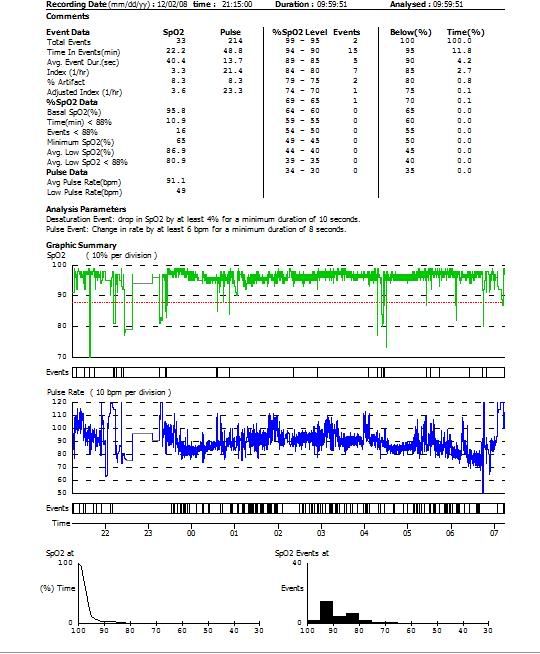
and from today while at work
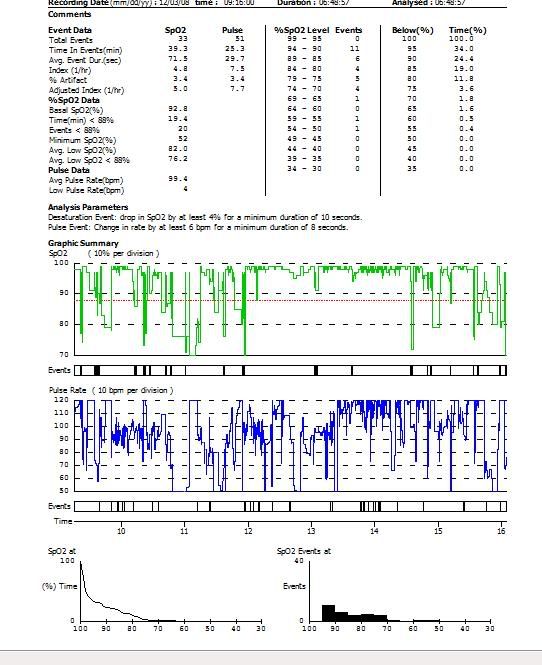
This unit seems to be very sensitive to movement, or else it has a loose wire somewhere. The numbers were wildly different for some of the time and nearly identical for some of the time. I understand the difference between a 1 second and a four second recording time (I think)
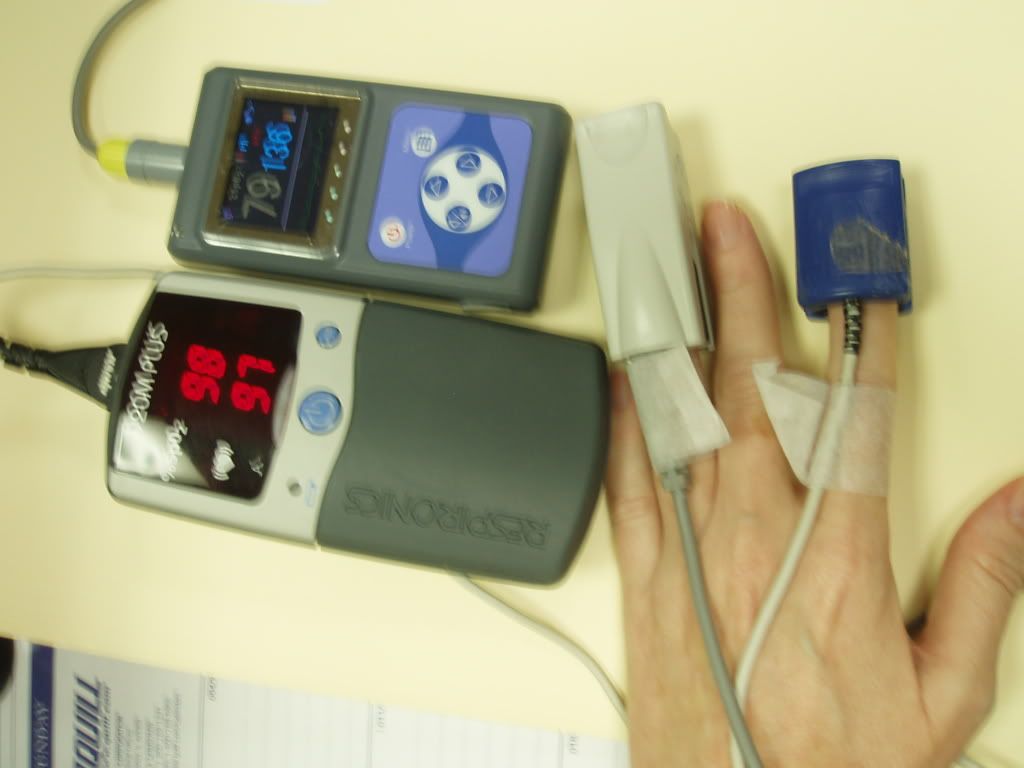
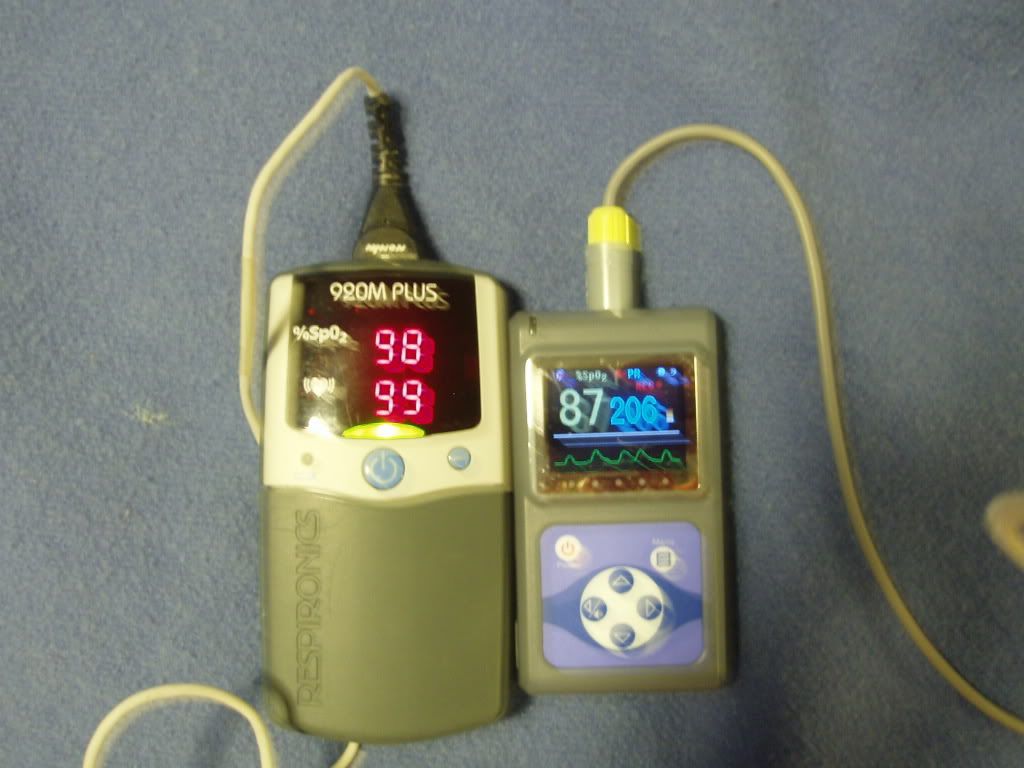
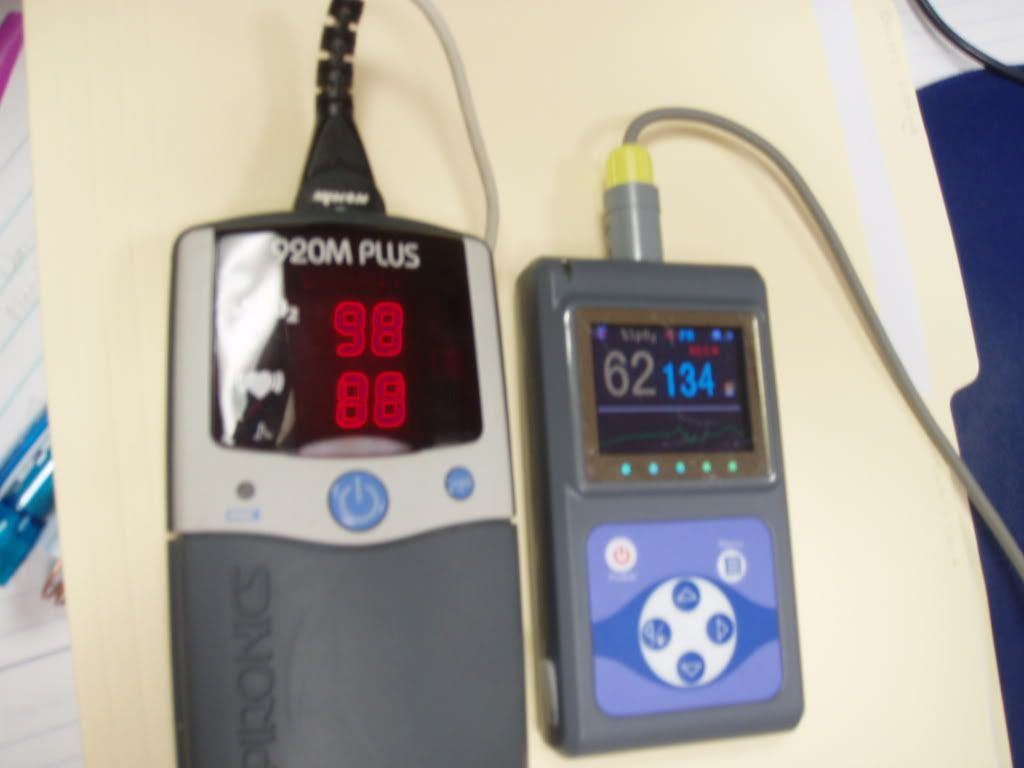
Everytime there is a disconnect, whether I'm moving or not, it seems to require a couple of minutes to get back on track.
What y'all think?
Bev

and from today while at work

This unit seems to be very sensitive to movement, or else it has a loose wire somewhere. The numbers were wildly different for some of the time and nearly identical for some of the time. I understand the difference between a 1 second and a four second recording time (I think)



Everytime there is a disconnect, whether I'm moving or not, it seems to require a couple of minutes to get back on track.
What y'all think?
Bev
Diagnosed 9/4/07
Sleep Study Titrated to 19 cm H2O
Rotating between Activa and Softgel
11/2/07 RemStar M Series Auto with AFlex 14-17
10/17/08 BiPAP Auto SV 13/13-23, BPM Auto, AHI avg <1
Sleep Study Titrated to 19 cm H2O
Rotating between Activa and Softgel
11/2/07 RemStar M Series Auto with AFlex 14-17
10/17/08 BiPAP Auto SV 13/13-23, BPM Auto, AHI avg <1










